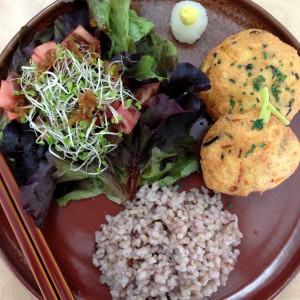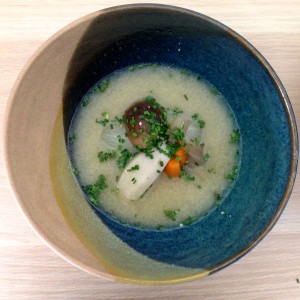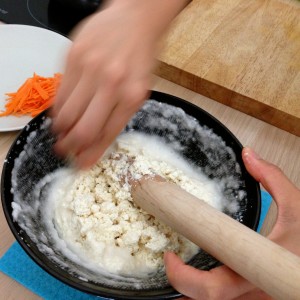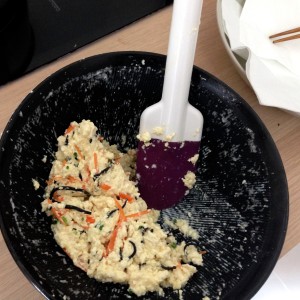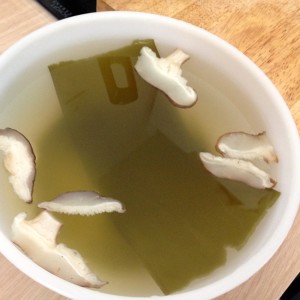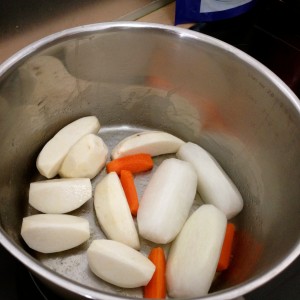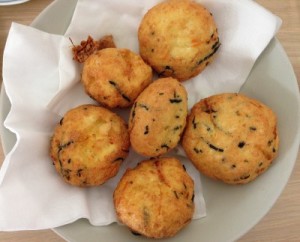cooking with miyuki
by sanae
Cooking with Miyuki is like watching a quiet, gentle dance. She embodies a breed of elegance I’ve rarely seen: she wields a knife with the precision of cooking school training and coordinates four dishes with flawless timing, while telling me about her childhood in the outskirts of Tokyo. Her mother was too busy to cook so Miyuki was in charge of the family kitchen at a young age. I like her openness, the way she asks direct questions in French (Do I meditate like my mother? Do I find French men to be different from Americans?). We listen to jazz as the rice cooks and kombu plumps in water. Junka, her toddler son, loves to dance. He prods the speakers and sways to music. Then he pushes a stool to the counter and looks at his mother cook.
Dashi is the base of Japanese cuisine, Miyuki explains. We rarely use water. Dashi to make soup, simmer vegetables, or thin a salad dressing. There are two main ingredients in dashi: kombu (kelp) and bonito flakes, or dried shiitake mushrooms for a vegetarian broth.
When she tastes broth Miyuki first spoons the liquid into a bowl, swishes it around, and pours it back into the pot. Only then does she spoon the broth a second time to taste. Does she do this to clean and warm the bowl? I’m reminded of a seaweed vendor in Kyoto who told me that broth should never taste too perfect or powerful upon a first sip. The flavor needs to mature and develop in the mouth. Cooks are impatient, she said, and they often over-salt. Another woman told me that only those who taste dashi at a young age have a refined enough palette for Japanese cooking. (Did you feed me dashi during my childhood? I quickly ask my mother. She nods.)
Miyuki is a professional cook and knows how to cook Chinese and French, though her specialty is Japanese cuisine. My mother met her through her husband, Lesly, who is a Tibetan-French translator and a shiatsu master. We cook in her apartment, a small one-bedroom with floor to ceiling windows and sparse furnishing. Rectangular tatami mats line the walls and paper lampshades hang from the ceiling. The kitchen is clean with beige counters, a wooden island where we eat, and two hot plates for cooking.
I went to a macrobiotic cooking class the other week, Miyuki says. The teacher was loud and outgoing. I’m not like that.
Miyuki worries she’s too quiet to be a cooking teacher. Who cares about chatter, I tell her. I’m enthralled by her poise. She wears the simplest clothes each time I see her: black pants and black top with a shot of color, slippers indoors and sneakers outside. She’s not reserved or shy, and she speaks through her hands, through the way she chops against her nails and through the tiny pinches of Himalayan salt and endless julienning. You want to be her friend, you want to cook with her, you want to never eat anything but Japanese home cooking.
With Miyuki I learn the art of sparseness and simplicity. Three shiitake mushrooms can go a long way in a delicate miso soup, same with a third of a carrot or a stick of celery. I’ve gotten used to large portions in America, of keeping leftovers in the fridge and freezing stew, even though my mother always cooked our meals à la minute, with no remains. From observing Miyuki, I learn:
A small pinch of salt may be enough for a clear broth (no need to throw in a teaspoon, trust your fingers for accuracy).
Sautéing vegetables in a few drops of sesame oil before adding the broth will lend the soup a nutty undertone. Cooking vegetables in a little oil helps them retain their vitamins.
The way you cut your vegetables does affect their flavor. Cut by hand, not with a mandolin. Take your time. You can’t press Japanese cooking; it’s all about the preparation.
A drop of mirin (sweet rice wine) balances the saltiness of salad dressing.
Always peel your tomatoes. They taste better and tomato skin is hard to digest. Slice the bottom skin of the tomato in a cross, pour hot water over the tomato, and quickly rinse with cold water. Then peel as you would a ripe peach.
If using little dried fish for broth, remove head and liver to avoid a bitter flavor.
Reflect on the colors of your dish: do you need green? If so, add a pinch of chopped chives.
A tablespoon of black rice mixed with brown (or white) rice will lend the rice an astonishing, reddish color.
Always keep your workspace clean. Miyuki has a small plastic bag on the counter into which she discards vegetable skin, fish ends, and so forth.
Ganmodoki (fried tofu), brown rice, miso soup, and salad with onion dressing
Disclaimer: press tofu for 4 hours between two heavy plates to remove liquid; soak kombu and dired shiitak in water overnight
Ingredients:
Rice
1.5 cups brown rice (or white, or a mix of white and brown, we used half-milled rice)
1 tablespoon black rice
1.5 cups water
Kasujiru soup
Kombu (big strip, the size of an envelope, see photo)
3 shiitake mushrooms
2 tablespoons miso paste
1 tablespoon brown rice amazake (sweet rice paste, if you can’t find, omit)
3cm white radish (daikon)
3cm taro
3cm carrot
3cm konnyaku
1 tsp. sesame oil
chives, finely chopped
salt, soy sauce
Salad
One ripe tomato
A handful of lettuce
A handful of sprouts
Sauce: 2 tablespoons soy sauce, juice of 1/8 lemon, 2 tbsp. caramelized onions*, 1 tsp. mirin
*Caramelized onions: finely chop one large onion and cook with plenty of olive oil for at least twenty minutes, until brown and sweet. Reserve oil and onions for dressing.
Ganmodoki (Fried Tofu balls)
430g tofu (firm)
5g or ¼ cup hijiki (dried seaweed)
1 egg
Carrot (3 cm piece), julienned
70-80g yam (not sweet potato! It has a hairy, hard skin. You may be allergic to the meat, use gloves to peel). You can use a tablespoon of cornstarch if you can’t find yams.
1 teaspoon toasted black sesame seeds
Salt, soy sauce
Small piece of daikon, grated
Small piece of ginger, grated
Utensil: large Japanese mortar and pestle (for grinding seeds)
Directions:
RICE
First, make the rice. Combine 1 tablespoon black rice with 1.5 cups haiga-mai “rice” (this is half-milled rice. Use white rice or a combination of white and brown if you can’t find it. I usually do 2/3 white, 1/3 brown). Wash rice and soak for 1.5 hours in 1.5 cups of water. Add a pinch of salt. Cook in your rice cooker, or in a deep saucepan (cover; cook over high flame until water boils; lower heat to minimum and cook for fifteen minutes; let rest for ten minutes before uncovering pot).
FRIED TOFU
Press tofu between two heavy plates for 4 hours to remove any excess water. Mash tofu in the Japanese mortar. You can also do this in a regular bowl. Do this in batches — otherwise you’ll find it difficult to mash the entire tofu in one go. Grate the yam against the upper sides of the mortar (see photo). Stir into the tofu. Add carrot, hijiki, teaspoon of black sesame, teaspoon of chopped chives, and egg. Stir well. Set aside in the fridge.
SALAD
Peel the tomato by slicing the skin at the top, pouring hot water over the tomato and rinsing under cold water. Cut into squares and set aside for the salad.
SOUP
In the meantime, prepare the soup:
Peel the taro and cut into quarters. Wash with salt and rinse. Cut carrot into thick sticks. Cut konnyaku into thin slices, cut a slit the middle, then twist. See here for directions! In a deep saucepan heat 1tsp. sesame oil and quickly sauté the daikon, carrots, and taro.
Broth: the night before, soak kombu in a large bowl filled with water (see photo). Add a few slices of dried shiitake. Set aside in the fridge.
Pour broth into a saucepan without the kombu and mushrooms. Measure the broth with a bowl to get a sense of how much you’d like for your meal.
Cook over medium heat until daikon is soft, but still firm. Skim the surface of the soup to remove white scum. Taro cooks faster than daikon. You may have to remove the taro once it’s cooked through so it doesn’t disintegrate in the soup, and then return to saucepan at the end. Add three shiitake mushrooms. Add two tablespoons of miso, the konnyaku, a pinch of salt, and a tablespoon of brown rice amazake. Cook for two minutes and turn off heat. Taste for salt. It should have a subtle, light flavor.
FRIED TOFU
Grate ginger and daikon for the fried tofu. Squeeze excess liquid from the daikon. Set aside (see photo).
Fill a deep saucepan with sunflower oil and place over medium flame. Check if the oil is hot enough for deep-frying with a chopstick: when you place the wooden chopstick in the oil small bubbles should form around the chopsticks. Take out the tofu mixture from the fridge and season with salt and soy sauce. Massage olive oil into your hands to prevent sticking. Form six balls with your hands, place them in the hot oil in two batches (three at a time), and fry until a light brown color, for about seven minutes. Let drain on paper towels.
SALAD
Make the salad sauce by stirring the soy sauce, lemon juice, caramelized onions (with the oil), and mirin. Sprinkle over lettuce and tomatoes.
Serve the rice, tofu and salad on one plate, and the soup in a bowl. Enjoy!

